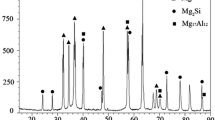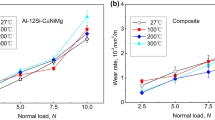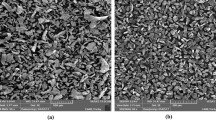Abstract
The phenomena associated with dry sliding wear of Mg-Ti3AlC2 composites have been investigated under a range of applied load, sliding velocity, and distance. Ti3AlC2 reinforcement of 20-40 vol.% was chosen to see the dependency of tribological responses such as coefficient of friction (CoF) and specific wear rate (SWR). Wear maps were also constructed to investigate variations in CoF and SWR with the aforementioned test variables. Our observation from those responses showed a marked decrease in CoF and SWR with an increase in load and speed. This phenomenon elucidates the ability of this composite to repair the worn-out surface. Compositional aspects of the tribo-film formed in the contact area showed the presence of mixed oxides enriched in Ti over Mg.









Similar content being viewed by others
References
P. Singh, H. Pungotra and N.S. Kalsi, On the Characteristics of Titanium Alloys for the Aircraft Applications, Mater. Today Proceed., 2017, 4(8), p 8971-8982.
W.J. Joost and P.E. Krajewski, Towards Magnesium Alloys for High-Volume Automotive Applications, Scr. Mater., 2017, 128, p 107-112.
L. Tian, A. Russell, T. Riedemann, S. Mueller and I. Anderson, A Deformation-Processed Al-Matrix/Ca-Nanofilamentary Composite with Low Density, High Strength, and High Conductivity, Mater. Sci. Eng. A., 2017, 690, p 348-354. https://doi.org/10.1016/j.msea.2017.03.010
W. Yu, Y. Cao, X. Li, Z. Guo and S. Xiong, Determination of Interfacial Heat Transfer Behavior at the Metal/Shot Sleeve of High Pressure Die Casting Process of AZ91D Alloy, J. Mater. Sci. Technol., 2017, 33(1), p 52-58. https://doi.org/10.1016/j.jmst.2016.02.003
H. Friedrich and S. Schumann, Research for A “New Age of Magnesium” in the Automotive Industry, J. Mater. Process. Technol., 2001, 117(3), p 276-281.
M.P. Staiger, A.M. Pietak, J. Huadmai and G. Dias, Magnesium and its Alloys as Orthopedic Biomaterials: A Review, Biomaterials, 2006, 27(9), p 1728-1734.
B. Song, N. Guo, T. Liu and Q. Yang, Improvement of Formability and Mechanical Properties of Magnesium Alloys via Pre-Twinning, Mater. Des., 2014, 62, p 352-360. https://doi.org/10.1016/j.matdes.2014.05.034
A.R. Natarajan, E.L.S. Solomon, B. Puchala, E.A. Marquis and A. Van der Ven, On the Early Stages of Precipitation in Dilute, Mg-Nd Alloys, Acta Mater., 2016, 108, p 367-379. https://doi.org/10.1016/j.actamat.2016.01.055
X.B. Chen, N. Birbilis and T.B. Abbott, Review of Corrosion-Resistant Conversion Coatings for Magnesium and its Alloys, Corrosion., 2011, 67(5), p 035005-01.
J. An, R.G. Li, Y. Lu, C.M. Chen, Y. Xu, X. Chen and L.M. Wang, Dry Sliding Wear Behavior of Magnesium Alloys, Wear., 2008, 265(1-2), p 97-104.
M. Nouri, X. Sun and D. Li, Beneficial Effects of Yttrium on the Performance of Mg-3%Al Alloy During Wear, Corrosion and Corrosive Wear, Tribol. Int., 2013, 67, p 154-163.
F. Labib, H.M. Ghasemi and R. Mahmudi, Dry Tribological Behavior of Mg/SiCp Composites at Room and Elevated Temperatures, Wear., 2016, 348(1), p 69-79.
L. Falcon-Franco, E. Bedolla-Becerril, J. Lemus-Ruiz, J.G. Gonzalez-Rodríguez, R. Guardian and I. Rosales, Wear Performance of TiC as Reinforcement of a Magnesium Alloy Matrix Composite, Compos. Part B-Eng., 2011, 42(2), p 275-279.
Y.T. Yao, L. Jiang, G.F. Fu and L.Q. Chen, Wear Behavior and Mechanism of B4C Reinforced Mg-Matrix Composites Fabricated by Metal-Assisted Pressureless Infiltration Technique, T. Nonferr. Metal. Soc., 2015, 25(8), p p2543-p2548.
A. Aatthisugan, D. Razal Rose and S. Jebadurai, Mechanical and Wear Behaviour of AZ91D Magnesium Matrix Hybrid Composite Reinforced with Boron Carbide and Graphite, J. Magnes. Alloy., 2017, 5(1), p 20-25.
A. Das and S.P. Harimkar, Effect of Graphene Nanoplate and Silicon Carbide Nanoparticle Reinforcement on Mechanical and Tribological Properties of Spark Plasma Sintered Magnesium Matrix Composites, J. Mater. Sci. Technol., 2014, 30(11), p 1059-1070.
I.M. Allam, Solid Lubricants Temperatures for Applications at Elevated Temperature, J. Mater. Sci., 1991, 26, p 3977–3984.
J. Cheng, S. Zhu, Y. Yu, J. Yang and W. Liu, Microstructure, Mechanical and Tribological Properties of TiAl-Based Composites Reinforced with High Volume Fraction of Nearly Network Ti2AlC Particulates, J. Mater. Sci. Technol., 2018, 34(4), p 670–678.
Z. Sun, Progress in Research and Development on MAX Phases: A Family of Layered Ternary Compounds, Int. Mater. Rev., 2011, 56, p 143–166.
Z. Feng, P. Ke and A. Wang, Preparation of Ti2AlC MAX Phase Coating by DC Magnetron Sputtering Deposition and Vacuum Heat Treatment, J. Mater. Sci. Technol., 2015, 31, p 1193–1197.
M.W. Barsoum and M. Radovic, Elastic and Mechanical Properties of the MAX Phases, Ann. Rev. Mater. Res., 2011, 41, p 195–227.
W. Yu, V. Mauchamp, T. Cabioc’h, D. Magne, L. Gence, L. Piraux, V. Gauthier-Brunet and S. Dubois, Solid Solution Effects in the Ti2Al(CxNy) MAX Phases: Synthesis, Microstructure, Electronic Structure and Transport Properties, Acta Mater., 2014, 80, p 421–34.
S. Myhra, J.W.B. Summers and E.H. Kisi, Ti3SiC2—a Layered Ceramic Exhibiting Ultra-Low Friction, Mater. Lett., 1999, 39(1), p 6–11.
L. Cai, Z. Huang, W. Hu, S. Hao, H. Zhai and Y. Zhou, Fabrication, Mechanical Properties, and Tribological Behaviors of Ti2AlC and Ti2AlSn0.2C Solid Solutions, J. Adv. Ceram., 2017, 6(2), p 90–99.
L. Xu, D. Zhu, S. Grasso, T.S. Suzuki, A. Kasahara, M. Tosa, B.-N. Kim, Y. Sakka, M. Zhu and C. Hu, Effect of Texture Microstructure on Tribological Properties of Tailored Ti3AlC2 Ceramic, J. Adv. Ceram., 2017, 6, p 120–128.
B. Anasori, E. Caspi and M.W. Barsoum, Fabrication and Mechanical Properties of Pressureless Melt Infiltrated Magnesium Alloy Composites Reinforced with TiC and Ti2AlC Particles, Mater. Sci. Eng. A, 2014, 618, p 511–522.
W. Yu, D. Chen, L. Tian, H. Zhao and X. Wang, Self-Lubricate and Anisotropic Wear Behavior of AZ91D Magnesium Alloy Reinforced with Ternary Ti2AlC MAX Phases, J. Mat. Sci. Tech., 2019, 35(3), p 275–284.
S. Amini, C.Y. Ni and M.W. Barsoum, Processing, Microstructural Characterization and Mechanical Properties of a Ti2AlC/nanocrystalline Mg-Matrix Composite, Comp. Sci Technol., 2009, 69(3), p 414–420.
S. Amini and M.W. Barsoum, On the Effect of Texture on the Mechanical and Damping Properties of Nanocrystalline Mg-Matrix Composites Reinforced with MAX Phases, Mat. Sci. Eng. A., 2010, 527(16), p 3707–3718.
J. Cheng, S. Zhu, Z. Qiao and J. Yang, Low Friction Properties of Ti3AlC2/SiC Tribo-Pair in Sea Water Environment, Tribol. Int., 2016, 103, p p228–p235.
M. Nelson, M.T. Agne, B. Anasori, J. Yang and M.W. Barsoum, Synthesis and Characterization of the Mechanical Properties of Ti3SiC2/Mg and Cr2AlC/Mg Alloy Composites, Mater. Sci. Eng. A, 2017, 705, p 182–188.
X. Shi, J. Yao, Z. Xu, W. Zhai, S. Song, M. Wang and Q. Zhang, Tribological Performance of TiAl Matrix Self-Lubricating Composites Containing Ag, Ti3SiC2 and BaF2/CaF2 Tested from Room Temperature to 600 °C, Mater. Des., 2014, 53, p 620–633. https://doi.org/10.1016/j.matdes.2013.07.053
S. Gupta, S. Amini, D. Filimonov, T. Palanisamy, T. El-Raghy and M.W. Barsoum, Tribological Behavior of Ti2SC at Ambient and Elevated Temperatures, J. Am. Ceram. Soc., 2007, 90(11), p 3566–3571.
B. Xue, Z. Xu, Q. Zhang, X. Shi, M. Wang, W. Zhai, J. Yao and S. Song, Tribological Properties of TiAl-Ti3SiC2 Composites, J. Wuhan Univ. Technol. Mater. Sci. Ed., 2014, 29(2), p 256–63.
L. Rangaraj, R.V. Sagar, M. Stalin, K. Raghavendra and K. Venkateswarlu, Synthesis, Characterization, and Mechanical Properties Evaluation of Mg-Ti3AlC2 Composites Produced by Powder Metallurgy/Hot Pressing, Met. Mat. Trans. A., 2019, 50(8), p 3714–3723.
ASTM G99-17 (2017): Standard Test Method for Wear Testing with a Pin-on-Disk Apparatus, West Conshohocken, PA: ASTM International, last updated Jan 20, ASTM International. doi: https://doi.org/10.1520/G0099-17
S.M. Hsu and M.C. Shen, Ceramic Wear Maps, Wear, 1996, 200(1), p 154-175.
M. Macedo De Matos, J.H. Luna-Domínguez, V. Verma, C.G. Schön and R.C. Cozza, Assessment of Micro-Abrasive Wear Tribological Properties of H10 Tool-Steel under Conditions of “Constant Normal Force⇒ Variable Pressure” and “Constant Pressure⇒ Variable Normal Force,” Wear., 2021, 476, p 203664.
T.Z. Wei, S.R.B. Shamsuri, C.S. Yee, M.W.A. Rashid and Q. Ahsan, Effect of Sliding Velocity on Wear Behavior of Magnesium Composite Reinforced with SiC and MWCNT, Proc. Engg., 2013, 68, p 703-709.
P. Narayanasamy and N. Selvakumar, Tensile, Compressive and Wear Behaviour of Self-Lubricating Sintered Magnesium Based Composites, Trans. Nonferr. Metal. Soc., 2017, 27(2), p 312-323.
L. Wang, Y. Yang, G. Yang, G. Shui and M. Wu, Self-Repairing and Tribological Behaviour of Steel–Steel Friction Pairs Lubricated with an Oil with Magnesium Silicate Hydrosilicate as Additive, Manuf. Rev., 2019, 6, p 1. https://doi.org/10.1051/mfreview/2018016
C. Liang, X. Han, T.F. Su, C. Li and J. An, Sliding Wear Map for AZ31 Magnesium Alloy, Tribol Trans., 2014, 57(6), p 1077-1085.
A.E.A. Al-Maamari, A.A. Iqbal and D.M. Nuruzzaman, Wear and Mechanical Characterization of Mg-Gr Self-Lubricating Composite Fabricated by Mechanical Alloying, J. Magnes. Alloy, 2019, 7(2), p 283-290.
Z. Xu, X. Shi, Q. Zhang, W. Zhai, J. Yao, L. Chen and Y. Xiao, Effect of Counterface Balls on the Friction Layer of Ni3Al Matrix Composites with 1.5wt.% Graphene Nanoplatelets, J. Mater. Eng. Perform., 2014, 23(2), p 2255-64.
S. Gupta and M.W. Barsoum, On the Tribology of the MAX Phases and Their Composites during Dry Sliding: A Review, Wear., 2011, 271(9), p 1878-1894.
W. Yuan, K.S. Chin, M. Hua, G. Dong and C. Wang, Shape Classification of Wear Particles by Image Boundary Analysis using Machine Learning Algorithms, Mech. Syst. Signal. Pr, 2016, 72, p 346-358.
Acknowledgments
The authors would like to acknowledge the grant support received from the AR & DB (Aeronautical Research and Development Board), New Delhi, Government of India (ARDB/01/2031765/M/I). We would like to thank Mrs Kalavati, from CSIR-NAL, for her participation in extensive SEM investigation.
Author information
Authors and Affiliations
Corresponding author
Additional information
Publisher's Note
Springer Nature remains neutral with regard to jurisdictional claims in published maps and institutional affiliations.
Appendices
Appendix 1
In the complete description of wear behavior, the whole tribosystem has a role. Therefore, we are presenting some additional data on the wear of the counter body, i.e., EN 24 disk against cylindrical pins of all the three composites (reinforced with 20, 30, and 40 vol.% of Ti3AlC2) and examination of the wear track. The wear data have been taken using 5 N load and 20 cm/sec of speed. The CoF and SWR are presented in Table
1. The wear tracks formed due to the abrasive pin of 20, 30, and 40 vol.% Mg-Ti3AlC2 composite pins are shown in Fig.
10. The respective wear tracks and their widths are shown in Fig. 10. As the volume fraction of Ti3AlC2 increases, width of the wear track also increases on the steel surface.
Appendix 2
In appendix 11, the CoF evolution with time is presented. This can be clearly seen that a rate of increase for 20 and 30 vol.% of Ti3AlC2 phase is extremely low. The composite with 40 vol.% of Ti3AlC2 phase exhibits a continuous increase in CoF with time. An explanation of this phenomenon is represented in Fig. 11(b). The transfer film formed during the wear at the steel-Mg-Ti3AlC2 composite interface is sticky, patchy, and viscous. The highly viscous nature of this film creates stick–slip condition at the interface. This stick–slip behavior gives rise to fluctuations in CoF–time response. The increase in CoF value with time can be seen for 30 and 40 vol.% of the composites. From the wear debris analysis, we got a rough estimate about the content of the film such as broken and intact Ti3AlC2 particles remaining in the transfer film. But when the amount of particles is higher as in the case of 30 and 40% Ti3AlC2-reinforced composites, this consistency of the transfer film is disintegrated and abrasive chunks with Ti3AlC2 particle core and smeared Mg-Ti-Al-Fe oxide films increase the resistance. Higher the particle content of the transfer film, the more fragile it is.
Rights and permissions
About this article
Cite this article
Barat, K., Bharata, Venkateswarlu, K. et al. Dry Sliding Wear Behavior of Magnesium Composites with Ti3AlC2 Reinforcement: Tribological Responses and Underlying Mechanisms. J. of Materi Eng and Perform 32, 4986–4997 (2023). https://doi.org/10.1007/s11665-022-07448-2
Received:
Revised:
Accepted:
Published:
Issue Date:
DOI: https://doi.org/10.1007/s11665-022-07448-2






